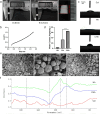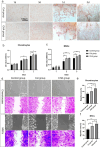A bilayer scaffold of collagen and nanohydroxyapatite promotes osteochondral defect in rabbit knee joints
- PMID: 40012526
- PMCID: PMC11865975
- DOI: 10.1302/2046-3758.142.BJR-2024-0171.R1
A bilayer scaffold of collagen and nanohydroxyapatite promotes osteochondral defect in rabbit knee joints
Erratum in
-
Corrigendum.Bone Joint Res. 2025 Mar 5;14(3):208. doi: 10.1302/2046-3758.143.BJR-2025-00002. Bone Joint Res. 2025. PMID: 40042505 Free PMC article. No abstract available.
Abstract
Aims: A large number of surgical operations are available to treat osteochondral defects of the knee. However, the knee joint arthroplasty materials cannot completely mimic the articular cartilage and subchondral bone, which may bring some obvious side effects. Thus, this study proposed a biocompatible osteochondral repair material prepared from a double-layer scaffold of collagen and nanohydroxyapatite (CHA), consisting of collagen hydrogel as the upper layer of the scaffold, and the composite of CHA as the lower layer of the scaffold.
Methods: The CHA scaffold was prepared, and properties including morphology, internal structure, and mechanical strength of the CHA scaffold were measured by scanning electron microscopy (SEM) and a MTS electronic universal testing machine. Then, biocompatibility and repair capability of the CHA scaffold were further evaluated using a rabbit knee cartilage defect model.
Results: The CHA scaffold was well suited for the repair of articular cartilage and subchondral bone; the in vitro results showed that the CHA scaffold had good cytocompatibility. In vivo experiments demonstrated that the material had high biocompatibility and effectively induced cartilage and subchondral bone regeneration.
Conclusion: The CHA scaffold has a high potential for commercialization and could be used as an effective knee repair material in clinical applications.
© 2025 Guo et al.
Conflict of interest statement
F. Chen reports funding from the Special Support Plan for High-level Talents (No. 334042000022) and Innovation Team Program in Shaanxi Province (No. 2019TD-032), related to this study. Z. Chen reports funding from the National Natural Science Foundation of P. R. China (No. 32171329) and Major special project of Qin Chuang Yuan (23LLRHZDZX0010), related to this study.
Figures






References
-
- Cavinatto L, Hinckel BB, Tomlinson RE, Gupta S, Farr J, Bartolozzi AR. The role of bone marrow aspirate concentrate for the treatment of focal chondral lesions of the knee: a systematic review and critical analysis of animal and clinical studies. Arthroscopy. 2019;35(6):1860–1877. doi: 10.1016/j.arthro.2018.11.073. - DOI - PubMed
Grants and funding
LinkOut - more resources
Full Text Sources

